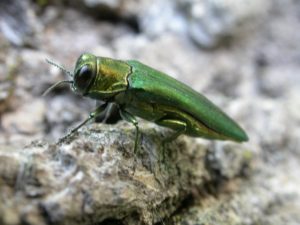In mid-May, the House Committee on Appropriations adopted two bills crucial to funding efforts to counter tree-killing non-native insects and diseases. Please let them know you are grateful.
APHIS funding
The Agriculture appropriations bill funds APHIS (and other USDA agencies) for Fiscal Year 2019 (which begins on October 1). The new bill provides a total of $998,353,000 to APHIS, an increase of $16.4 million above the FY18 level and $259 million above the Administration’s request. ( I blogged about the Administration’s alarming request here.) You can find the bill here; the more informative report is posted here. Use search words to find specific APHIS programs.
The pest-related funding is apportioned among several areas:
Tree and Wood Pest Program. Unlike in previous years, the House bill does not cut funds for this program – which funds efforts to eradicate or contain the Asian longhorned beetle, emerald ash borer, and European gypsy moth. Instead, it maintains funding at the FY18 level of $54 million. Under the circumstances, this is good news. Thank you for your efforts to educate members of the House subcommittee on agricultural appropriations about this crucial program! (In past years, we relied on the Senate to restore funding for the Tree and Wood Pest Program.)
Specialty Crop Pests Program. The House increased funding by $10.8 million here, and specified that $15 million target the spotted lanternfly. This recently detected Asian leafhopper is spreading in southeastern Pennsylvania and was recently confirmed in Virginia’s Shenandoah Valley. It is a pest of native hardwood trees as well as of orchard and other crops.
Also, the Committee used its report to stress several concerns:
Access to emergency funding. In the report, the House Appropriations Committee reiterates its longstanding instruction that the USDA Secretary continue to use his authority to transfer funds from the Commodity Credit Corporation. They support using these funds – above and beyond appropriated funds – for the arrest and eradication of animal and plant pests and diseases that threaten American agriculture.
 Brown Apple Moth vs. Emerald Ash Borer. Interestingly, the House Appropriations Committee encourages APHIS to engage state and international regulatory bodies as it moves to deregulate the light brown apple moth. The Committee expresses concern that if APHIS simply withdraws federal regulation without the necessary work with other officials, it will shift, not reduce, the regulatory burden. Then growers would carry the burden of preventing spread of the pest. I wish the Committee had made the same statement vis a vis the emerald ash borer! APHIS also plans to stop regulating this insect which continues to threaten still-uninvaded portions of the United States and Mexico.
Brown Apple Moth vs. Emerald Ash Borer. Interestingly, the House Appropriations Committee encourages APHIS to engage state and international regulatory bodies as it moves to deregulate the light brown apple moth. The Committee expresses concern that if APHIS simply withdraws federal regulation without the necessary work with other officials, it will shift, not reduce, the regulatory burden. Then growers would carry the burden of preventing spread of the pest. I wish the Committee had made the same statement vis a vis the emerald ash borer! APHIS also plans to stop regulating this insect which continues to threaten still-uninvaded portions of the United States and Mexico.
Micornesia and Hawai’i. The Committee also instructs the Secretary of Agriculture to report to both the House and Senate Committees on Appropriations its progress implementing the Regional Biosecurity Plan for Micronesia and Hawai`i. This plan combines efforts by the U.S. Department of Defense, Department of the Navy, and the island governments to prevent transport of invasive species as a consequence of relocating military personnel from a base in Okinawa, Japan. More information is available here.
Forest Service funding
The Interior appropriations bill funds the US Forest Service (as well as Interior Department and Environmental Protection Agency).
Forest Health Management Program. The bill provides an increase of $19.5 million above FY18 levels for the forest health management program ($30 million above the Administration’s request). The Committee instructs the Forest Service to “work in concert with Federal agencies, States, and other entities to prioritize the allocation of these funds to address the greatest threats.” The emerald ash borer, “bark beetle” (which ones?) and cogon grass are expressly mentioned. The report is posted here. (It is unclear what actions the Forest Service is expected to take on the EAB, since regulations intended to curtail people from moving infested wood will soon be dropped by APHIS. The Forest Service could support breeding of ash trees resistant to the beetle.)
Forest Service Research. The Interior appropriations bill also maintained funding for Forest Service research at the FY18 level of $297 million – rather than cutting it to $259 million as advocated by the Administration. The Committee has called for the USFS to act within one year to “strengthen” its research program. The Committee expressly avoids endorsing several priorities advocated by Members of Congress while waiting for the Forest Service to implement this instruction.
If your representative is a member of the House Appropriations Committee (members listed here), please thank them for supporting APHIS’ and USFS’ programs. These funding increases shift several years of decline and are a true win for protecting our forests from non-native insects and pathogens!
Posted by Faith Campbell
We welcome comments that supplement or correct factual information, suggest new approaches, or promote thoughtful consideration. We post comments that disagree with us — but not those we judge to be not civil or inflammatory.

